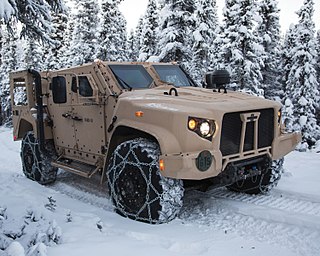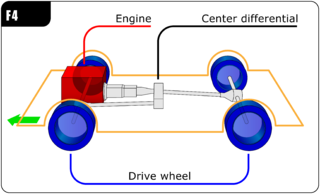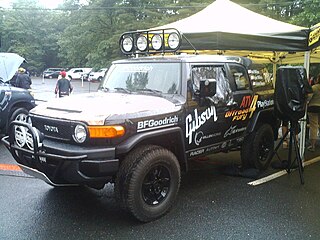
Four-wheel drive, also called 4×4 or 4WD, refers to a two-axled vehicle drivetrain capable of providing torque to all of its wheels simultaneously. It may be full-time or on-demand, and is typically linked via a transfer case providing an additional output drive shaft and, in many instances, additional gear ranges.

Propulsion transmission is the mode of transmitting and controlling propulsion power of a machine. The term transmission properly refers to the whole drivetrain, including clutch, gearbox, prop shaft, differential, and final drive shafts. In the United States the term is sometimes used in casual speech to refer more specifically to the gearbox alone, and detailed usage differs. The transmission reduces the higher engine speed to the slower wheel speed, increasing torque in the process. Transmissions are also used on pedal bicycles, fixed machines, and where different rotational speeds and torques are adapted.

A diesel–electric transmission, or diesel–electric powertrain is a transmission system for vehicles powered by diesel engines in road, rail, and marine transport. Diesel–electric transmission is based on petrol–electric transmission, a very similar transmission system used for petrol engines.

In automotive design, a front-engine, front-wheel-drive (FWD) layout, or FF layout, places both the internal combustion engine and driven roadwheels at the front of the vehicle.

A drive shaft, driveshaft, driving shaft, tailshaft, propeller shaft, or Cardan shaft is a component for transmitting mechanical power and torque and rotation, usually used to connect other components of a drivetrain that cannot be connected directly because of distance or the need to allow for relative movement between them.
Global Hybrid Cooperation, formerly Advanced Hybrid System 2 (AHS2), is a set of hybrid vehicle technologies jointly developed by General Motors, Daimler, and Chrysler LLC, with BMW joining in 2005. It uses 2 or 3 planetary gearsets in an automatic transmission: one on the internal combustion engine (ICE) side paired with a second, forming the compound split, and possibly one third additional planetary gearset to multiply the number of fixed gear ratios. General Motors has stopped using the "AHS2" name as of 2006, preferring to call it simply a two-mode hybrid system.
Hybrid Synergy Drive (HSD), also known as Toyota Hybrid System II, is the brand name of Toyota Motor Corporation for the hybrid car drive train technology used in vehicles with the Toyota and Lexus marques. First introduced on the Prius, the technology is an option on several other Toyota and Lexus vehicles and has been adapted for the electric drive system of the hydrogen-powered Mirai, and for a plug-in hybrid version of the Prius. Previously, Toyota also licensed its HSD technology to Nissan for use in its Nissan Altima Hybrid. Its parts supplier Aisin Seiki Co. offers similar hybrid transmissions to other car companies.

A drive wheel is a wheel of a motor vehicle that transmits force, transforming torque into tractive force from the tires to the road, causing the vehicle to move. The powertrain delivers enough torque to the wheel to overcome stationary forces, resulting in the vehicle moving forwards or backwards.
Hybrid vehicle drivetrains transmit power to the driving wheels for hybrid vehicles. A hybrid vehicle has multiple forms of motive power.
The following outline is provided as an overview of and topical guide to automobiles:

The Joint Light Tactical Vehicle (JLTV) is a United States military and United States Special Operations Command program to part-replace the Humvee with a family of more survivable vehicles with greater payload. Early studies for the JLTV program were approved in 2006. The JLTV program incorporates lessons learned from the earlier Future Tactical Truck Systems program and other associated efforts.

In automotive design, an F4, or front-engine, four-wheel drive (4WD) layout places the internal combustion engine at the front of the vehicle and drives all four roadwheels. This layout is typically chosen for better control on many surfaces, and is an important part of rally racing, as well as off-road driving. In terms of racing purposes, whether it be on-road or off-road, can be described as follows,
A team that pursues the Weak LS4WD architecture will minimize the development cost of the front-wheel drive system at the expense of having a larger rear powertrain. The Weak architecture produces a vehicle with a large powersplit between the front and rear powertrains, while the Strong architecture recommends a vehicle with more similar power and torque requirements for the front and rear.

MillenWorks, known as Rod Millen Motorsports until 2005, was an American automotive technology company started by Rod Millen in 1980. The company began by preparing Millen's rally cars, and evolved into designing and building them. The company developed vehicles, high performance auto parts, and technology for racing, concept cars, and the US military.

A rear-engine, front-wheel-drive layout is one in which the engine is between or behind the rear wheels, and drives the front wheels via a driveshaft, the complete reverse of a conventional front-engine, rear-wheel-drive vehicle layout.

The wheel hub motor is an electric motor that is incorporated into the hub of a wheel and drives it directly.
Torque vectoring is a technology employed in automobile differentials that has the ability to vary the torque to each half-shaft with an electronic system. This method of power transfer has recently become popular in all-wheel drive vehicles. Some newer front-wheel drive vehicles also have a basic torque vectoring differential. As technology in the automotive industry improves, more vehicles are equipped with torque vectoring differentials. This allows for the wheels to grip the road for better launch and handling.

The Oshkosh L-ATV is a light utility/combat multi-role vehicle that won the US military's Army-led Joint Light Tactical Vehicle (JLTV) program. In the very early stages of the program it was suggested that JLTV would replace the AM General High Mobility Multi-purpose Wheeled Vehicle (HMMWV) on a one-for-one basis. It is now suggested that the JLTV will part-replace the HMMWV, not replace it on a like-for-like basis.

In automotive engineering, the drivetrain is the group of components of a motor vehicle that deliver power to the drive wheels. This excludes the engine or motor that generates the power.

The Subaru Hybrid Tourer is a hybrid concept sport utility/grand touring vehicle designed and built by Subaru, unveiled at the 2009 Tokyo Motor Show. The Hybrid Tourer included several signature Subaru design features, such as the use of a horizontally-opposed engine and all-wheel drive, and built on prior Subaru hybrid concepts such as the B9SC and B5-TPH by using a two-motor layout. The Hybrid Tourer was succeeded by the 2011 Advanced Tourer concept and the 2013-15 VIZIV diesel hybrid concept series.
In automotive design, dual-motor, four-wheel-drive layout is mainly used by battery electric vehicles by placing electric motors on both front and rear axles and drives all four roadwheels, creating a four-wheel drive layout. This layout is made possible by the small size of electric motors compared to internal combustion engines, allowing it to be placed in multiple locations. It also eliminates the need of a drive shaft that are commonly used by conventional four-wheel drive vehicles to create space for batteries that are commonly mounted on the floor of electric vehicles.